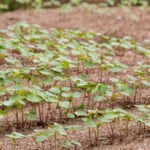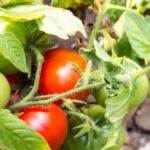Diatomaceous earth is a natural substance that has gained popularity among gardeners for its versatile uses in gardens. Composed of fossilized remains of tiny aquatic organisms called diatoms, it is a powdery substance that can be sprinkled onto the soil or applied as a dust to control pests, improve soil health, and suppress weeds. In this article, we will explore the safety aspects of using garden safe diatomaceous earth in vegetable gardens and its potential benefits.
Diatomaceous earth serves multiple purposes in gardens, making it a valuable tool for gardeners. As a pest control method, it is effective against various insects, including aphids, ants, slugs, and beetles. It works by dehydrating these pests upon contact, causing damage to their exoskeletons and ultimately leading to their demise.
Additionally, diatomaceous earth can improve soil structure by increasing water retention and providing essential minerals such as silica. Furthermore, it acts as a natural weed control measure by creating an inhospitable environment for weed growth.
Understanding the safety of using diatomaceous earth in vegetable gardens is crucial for ensuring the well-being of both plants and humans. Many concerns or misconceptions revolve around the potential harm diatomaceous earth may cause due to its powdery nature. However, garden safe diatomaceous earth is usually free from harmful chemicals or additives that could pose risks to crops or humans when used as directed.
Its natural origin makes it an attractive option for those seeking organic gardening solutions. In the following sections, we will delve further into the safety aspects of using diatomaceous earth in vegetable gardens while exploring its specific benefits and effective application techniques.
Understanding the Safety of Diatomaceous Earth
Diatomaceous earth is widely used in gardening for its numerous benefits, including pest control, soil improvement, and weed control. However, before incorporating it into your vegetable garden, it is essential to understand the safety aspects of using diatomaceous earth.
One common concern regarding the safety of diatomaceous earth is its composition. Diatomaceous earth is primarily composed of fossilized remains of diatoms, which are tiny aquatic organisms. These remains contain silica and other minerals that give diatomaceous earth its abrasive properties. It is important to note that food-grade diatomaceous earth, which is recommended for use in gardens, undergoes a purification process to eliminate impurities and harmful substances.
Another misconception about the safety of diatomaceous earth is its association with harmful chemicals. Unlike synthetic pesticides or insecticides, diatomaceous earth works mechanically rather than chemically. It kills pests by absorbing their protective wax layer, causing them to dehydrate and ultimately perish. This natural mode of action makes it safe for use around humans and animals.
Furthermore, food-grade diatomaceous earth derives from natural sources without the addition of any toxic chemicals or additives. It does not pose risks to beneficial insects like bees or ladybugs that play crucial roles in pollination and pest control within vegetable gardens.
Benefits of Using Diatomaceous Earth in Vegetable Gardens
Diatomaceous earth offers several benefits when used in vegetable gardens. One of the main advantages is its effectiveness in controlling pests without harming crops. Diatomaceous earth contains microscopic sharp edges that can puncture the exoskeletons of insects, causing them to dehydrate and die. This makes it a natural and non-toxic alternative to chemical pesticides.
In addition to pest control, diatomaceous earth can also improve soil health and enhance plant growth. When applied to the soil, it helps retain moisture by absorbing excess water and releasing it gradually. This can be especially beneficial for vegetables that require consistent moisture levels, such as tomatoes or lettuce.
Furthermore, diatomaceous earth acts as a natural fertilizer by providing essential minerals to the soil. It is rich in silica, which is known to strengthen cell walls in plants and promote overall plant vigor. Silica also has potential anti-fungal properties, which can help prevent diseases like powdery mildew from affecting vegetable crops.
| Benefits | Description |
|---|---|
| Pest Control | Diatomaceous earth effectively controls pests without harming crops. |
| Soil Improvement | It improves soil health by retaining moisture and providing essential minerals. |
| Enhanced Plant Growth | The presence of silica promotes stronger cell walls and overall plant vigor. |
By incorporating diatomaceous earth into their vegetable gardens, growers can reap these beneficial effects while minimizing the use of synthetic chemicals.
Selected Vegetable Garden Pests and Diatomaceous Earth’s Impact
Identifying Common Vegetable Garden Pests
Before discussing the impact of diatomaceous earth on vegetable garden pests, it is important to be familiar with some of the most common culprits that can wreak havoc on your precious crops. The following pests are frequently encountered in vegetable gardens:
- Aphids: These small, soft-bodied insects feed on plant sap and can rapidly multiply, causing damage to leaves, stems, and buds.
- Flea Beetles: Tiny black or brown beetles that jump when disturbed, flea beetles chew small holes in plant leaves, resulting in a “shot-hole” appearance.
- Cabbage Worms: Also known as cabbage loopers or diamondback moths’ larvae, cabbage worms feed on brassicas-such as cabbage, kale, and broccoli-and can quickly defoliate entire plants.
- Tomato Hornworms: These large green caterpillars can devour tomato plants within days if left unchecked.
- Squash Bugs: Arched-backed pests that attack squash plants by sucking sap from the leaves and fruit.
- Slugs and Snails: Slimy mollusks that leave behind silver trails as they munch on young seedlings and tender foliage.
Using Diatomaceous Earth against Garden Pests
Diatomaceous earth has proven to be an effective tool in controlling these troublesome pests while being safe for use in vegetable gardens. Its abrasive texture damages the exoskeleton of insects upon contact, leading to dehydration and eventual death. When applying diatomaceous earth to combat garden pests, keep the following tips in mind:
- Targeted Applications: Applying diatomaceous earth directly to affected areas where pests are present will yield optimal results.
- Thorough Coverage: Ensure all susceptible parts of the plant are dusted with diatomaceous earth, including the underside of leaves and stems.
- Reapplication: After rain or heavy watering, diatomaceous earth may lose its effectiveness. Reapply as necessary to maintain a barrier against pests.
- Timing and Frequency: Start applying diatomaceous earth early in the growing season to prevent pests from establishing populations. Follow specific product instructions for recommended frequency of application.
Case Studies Demonstrating Diatomaceous Earth’s Effectiveness
Numerous vegetable gardeners have reported successful outcomes when using diatomaceous earth to combat specific pests. Here are a few examples:
- One gardener battled a severe aphid infestation on their pepper plants by dusting them with food-grade diatomaceous earth. Within a week, the aphid population significantly decreased, and new growth appeared healthy and undisturbed.
- A tomato grower noticed recurring issues with tomato hornworms decimating their crop every season. After employing diatomaceous earth as a preventive measure, they observed a notable reduction in hornworm presence, resulting in healthier plants and higher yields.
These case studies highlight the efficacy of using diatomaceous earth as part of an integrated pest management strategy in vegetable gardens. However, it is important to remember that individual results may vary depending on factors such as pest populations, timing of application, and overall garden conditions. Before applying diatomaceous earth or any other product, it is advisable to conduct thorough research and consider consulting local gardening experts for tailored advice based on your specific circumstances.
Application and Guidelines for Using Diatomaceous Earth in Vegetable Gardens
Using diatomaceous earth in vegetable gardens can be an effective way to control pests and improve soil health. However, it is important to follow proper application guidelines to ensure safety and maximize its benefits. Here are some step-by-step instructions on how to use diatomaceous earth in your vegetable garden:
- Preparation: Before applying diatomaceous earth, make sure to wear protective gloves, a mask, and goggles to avoid any irritation or inhalation of the fine particles. Clear the area of any debris or weeds, and remove any ripe fruits or vegetables.
- Identification of Target Pests: Identify the specific pests affecting your vegetable garden so that you can apply diatomaceous earth directly to those areas. Common pests include aphids, slugs, beetles, caterpillars, and mites.
- Dust Application: Sprinkle a thin layer of diatomaceous earth over the affected plants or areas where pests are present. Pay extra attention to the undersides of leaves and stems where insects tend to hide. A handheld duster or a shaker bottle can help distribute the powder evenly.
- Frequency: For best results, reapply diatomaceous earth after rain or every 7-10 days if necessary. Continuous application is essential as new eggs may hatch during this time.
- Safety Precautions: While diatomaceous earth is generally safe for humans and animals once it settles onto surfaces, it should still be handled with care during application. Avoid direct contact with eyes or inhaling large amounts of dust.
It is important to note that using excessive amounts of diatomaceous earth does not provide better results and may harm beneficial insects. Therefore, it is crucial to follow the recommended quantities and guidelines provided by the manufacturer.
Ultimately, every vegetable garden is unique, and factors such as the severity of pest infestation, specific vegetables grown, and personal preferences will influence how diatomaceous earth is used in each garden. Consult with professionals or experienced gardeners for advice tailored to your specific gardening needs.
In addition to using diatomaceous earth, implementing other preventive measures such as proper sanitation practices, crop rotation, and companion planting can further enhance the effectiveness of pest control in your vegetable garden. Experimenting with different techniques will help you find the best approach that suits your gardening style and yields a bountiful harvest.
Potential Risks and Considerations of Using Diatomaceous Earth in Vegetable Gardens
Diatomaceous earth is generally considered to be safe for use in vegetable gardens, but there are some potential risks and considerations to keep in mind. While diatomaceous earth is a natural substance that does not contain harmful chemicals, it is important to take certain precautions when using it.
One potential risk of using diatomaceous earth is the possibility of inhalation. Diatomaceous earth is a fine powder that can become airborne easily, especially when it is being applied. Inhalation of the powder can irritate the respiratory system, so it is recommended to wear a dust mask or other protective gear during application.
Another consideration is that diatomaceous earth can be harmful to beneficial insects such as bees and butterflies. While it primarily targets pests, it may also affect non-target insects if they come into contact with the substance. To minimize harm to beneficial insects, it is advised to apply diatomaceous earth directly to problem areas rather than broadcasting it across the entire garden.
Additionally, some vegetables may be more sensitive to diatomaceous earth than others. Leafy greens like lettuce and spinach, for example, may be more prone to damage from the abrasive particles in diatomaceous earth. It is important to read product labels and follow instructions carefully to ensure that you are using a suitable form of diatomaceous earth for your specific vegetables.
If you have concerns about using diatomaceous earth or prefer alternative pest control methods, there are other options available. Some gardeners opt for organic insecticides or companion planting strategies to manage pests in their vegetable gardens.
Overall, while diatomaceous earth can be an effective and natural pest control option for vegetable gardens, it is important to weigh the potential risks and consider your specific gardening needs before use. By taking appropriate precautions and considering alternative methods if needed, you can make an informed decision regarding its suitability for your vegetable garden.
| Potential Risks | Considerations |
|---|---|
| – Inhalation risks | – Harm to beneficial insects |
| – Sensitivity of certain vegetables | – Alternative pest control methods |
Testimonials and Experiences from Vegetable Gardeners
Success Stories from Vegetable Gardeners
Diatomaceous earth has gained popularity among vegetable gardeners for its effectiveness and safety in controlling pests without harming crops. Many gardeners have shared their success stories and positive experiences with diatomaceous earth.
One gardener, Sarah, reported that she had struggled with aphid infestations on her lettuce plants for years. She decided to try diatomaceous earth as a natural pest control method after hearing about its benefits.
Sarah applied a thin layer of diatomaceous earth around the base of her lettuce plants, creating a barrier that prevented the aphids from reaching the leaves. Within a week, she noticed a significant reduction in aphid populations and was able to harvest healthy lettuce without any signs of damage.
Another gardener, Mark, shared his experience using diatomaceous earth to combat slugs in his tomato garden. Slugs had been feasting on his ripe tomatoes before he discovered the power of diatomaceous earth. Mark sprinkled a generous amount of diatomaceous earth around the perimeter of his tomato plants.
The sharp edges of the diatoms scratched the slugs’ bodies, causing them to dehydrate and die. He was amazed by how quickly and effectively diatomaceous earth solved his slug problem while leaving no harmful residue on his tomatoes.
Feedback on Safety for Vegetable Gardens
Aside from being effective against pests, many vegetable gardeners have also praised diatomaceous earth for its safety in vegetable gardens. Wendy, an organic gardener, expressed her satisfaction with using diatomaceous earth as a means to control pests without compromising the integrity of her vegetables. She highlighted that diatomaceous earth is natural and free from harmful chemicals often found in synthetic pesticides. Additionally, Wendy appreciated how easy it was to apply and maintain in her garden.
Tom, another vegetable gardener, commented on the peace of mind that diatomaceous earth provided him in terms of food safety. He noted that using diatomaceous earth allowed him to grow pesticide-free vegetables and enjoy them straight from his garden. Tom was particularly concerned about the health risks associated with chemical pesticides, making diatomaceous earth a valuable and safe alternative for him.
These testimonials from vegetable gardeners demonstrate the positive experiences and satisfactory results achieved through the use of diatomaceous earth in vegetable gardens. By utilizing this natural substance, gardeners have effectively controlled pests while ensuring the safety of their crops for consumption.
Frequently Asked Questions (FAQs) about Diatomaceous Earth in Vegetable Gardens
Is diatomaceous earth safe for edible crops?
Yes, diatomaceous earth is safe for use on edible crops in vegetable gardens. It works by physically dehydrating insects and pests, causing them to die. Since it acts mechanically rather than chemically, it does not leave any residue on the plants or vegetables. Therefore, when used correctly, it poses no health risks to humans or animals who consume the crops.
Will diatomaceous earth harm beneficial insects?
Diatomaceous earth is considered safe for beneficial insects such as bees, ladybugs, and butterflies. It specifically targets pests and insects with exoskeletons, while leaving beneficial bugs unharmed. However, it’s important to apply the diatomaceous earth directly to problem areas and avoid excessive usage that may potentially harm beneficial insects.
How often should I apply diatomaceous earth in my vegetable garden?
The frequency of applying diatomaceous earth in your vegetable garden depends on the severity of pest infestation and weather conditions. As a general guideline, it is recommended to reapply after rain or watering as this can wash away the powder. Additionally, continuous monitoring of pest activity will help determine when a reapplication is necessary.
Can I use diatomaceous earth around my root vegetables?
While diatomaceous earth is generally safe for most vegetables, caution should be exercised when using it around root vegetables like carrots and potatoes. The finer particles of diatomaceous earth may cling to the roots and become difficult to wash off before consumption. In such cases, it is advisable to avoid direct application near root crops or opt for alternative pest control methods.
Are there any precautions I need to take when handling diatomaceous earth?
When handling diatomaceous earth, it is recommended to wear gloves and a protective mask to avoid inhaling the fine particles. Although diatomaceous earth is non-toxic, prolonged exposure to large amounts of dust may cause respiratory irritation. It is also essential to follow the manufacturer’s instructions regarding application rates and safety precautions.
These were just a few frequently asked questions about using diatomaceous earth in vegetable gardens. If you have more concerns or queries, please feel free to ask below or seek advice from local gardening experts. Remember, making an informed decision is crucial for the health and success of your vegetable garden.
Conclusion
In conclusion, whether or not to use diatomaceous earth in your vegetable garden ultimately comes down to making an informed decision based on your individual gardening needs. Throughout this article, we have explored the uses, safety aspects, benefits, application guidelines, potential risks, and testimonials of diatomaceous earth in vegetable gardens.
Diatomaceous earth is a versatile substance that can be effectively used for pest control, soil improvement, and weed control. It is a natural product composed of fossilized remains of diatoms and does not contain harmful chemicals. When used correctly, it can help to enhance plant growth and protect crops from pests without causing harm.
While diatomaceous earth has proven to be successful against common vegetable garden pests such as slugs, snails, aphids, and beetles, it may not be suitable for all vegetables or garden setups. Some considerations include the specific pests present in your garden and the potential for beneficial insects to be affected by the product.
It is important to conduct further research and consider all factors before deciding whether or not to use diatomaceous earth in your vegetable garden. Taking into account your gardening goals, personal preferences, and any potential risks associated with its use will enable you to make an informed decision that aligns with your specific needs.
Remember that every garden is unique, and what works for one gardener may not work for another. By weighing the benefits and safety aspects of using diatomaceous earth alongside other pest control methods available to you, you can choose the best approach for maintaining a healthy and productive vegetable garden.

If you’re looking to get into vegetable gardening, or are just looking for some tips on how to make your current garden better, then you’ve come to the right place! My name is Ethel and I have been gardening for years. In this blog, I’m going to share with you some of my best tips on how to create a successful vegetable garden.





